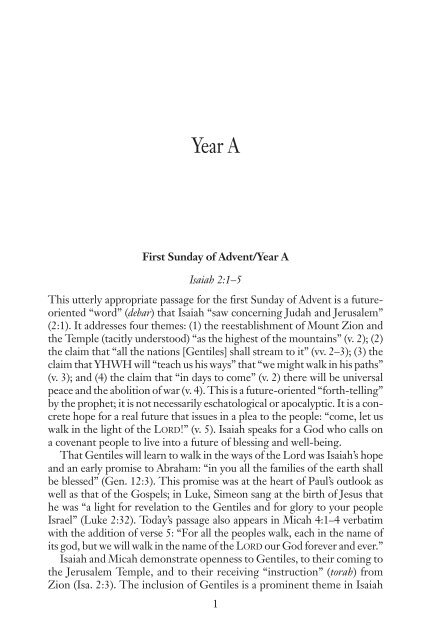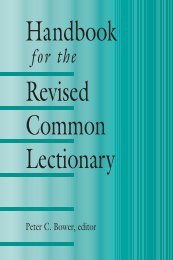- Page 1: Preaching the Old Testament
- Page 4 and 5: © 2007 Ronald J. Allen and Clark M
- Page 7 and 8: Contents Introduction xiii Year A F
- Page 9 and 10: Contents ix Third Sunday of Advent/
- Page 11 and 12: Contents xi Ash Wednesday/Year C 22
- Page 13 and 14: Introduction This volume is a compa
- Page 15 and 16: Introduction xv Preachers and congr
- Page 17 and 18: Introduction xvii than fifty-five O
- Page 19 and 20: ut then the lectionary departs from
- Page 21: Introduction xxi As noted previousl
- Page 25 and 26: Second Sunday of Advent/Year A 3 1/
- Page 27 and 28: Third Sunday of Advent/Year A 5 “
- Page 29 and 30: Christmas Day 1/Years A, B, and C 7
- Page 31 and 32: Christmas Day 2/Years A, B, and C 9
- Page 33 and 34: First Sunday after Christmas Day/Ye
- Page 35 and 36: Second Sunday after Christmas Day/Y
- Page 37 and 38: First Sunday after the Epiphany/Yea
- Page 39 and 40: Second Sunday after the Epiphany/Ye
- Page 41 and 42: Fourth Sunday after the Epiphany/Ye
- Page 43 and 44: Fifth Sunday after the Epiphany/Yea
- Page 45 and 46: Seventh Sunday after the Epiphany/Y
- Page 47 and 48: Eighth Sunday after the Epiphany/Ye
- Page 49 and 50: Ninth Sunday after the Epiphany/Yea
- Page 51 and 52: Ash Wednesday/Years A, B, and C 29
- Page 53 and 54: viously unseen devastation in its w
- Page 55 and 56: According to Rabbi Nathan 1), but G
- Page 57 and 58: There is testing of another kind go
- Page 59 and 60: nations that collapsed and their le
- Page 61 and 62: Palm/Passion Sunday/Years A, B, and
- Page 63 and 64: Good Friday/Year A 41 munity. Indee
- Page 65 and 66: The lectionary today provides alter
- Page 67 and 68: Trinity Sunday/Year A 45 and unjust
- Page 69 and 70: Proper 4 [9]/Year A 47 the world (e
- Page 71 and 72: Proper 5 [10]/Year A 49 The Lord co
- Page 73 and 74:
The third significant motif in the
- Page 75 and 76:
Instead we note that Exodus all alo
- Page 77 and 78:
Proper 8 [13]/Year A 55 the listene
- Page 79 and 80:
stand why judgment has fallen upon
- Page 81 and 82:
the eschatological realm of God (Lu
- Page 83 and 84:
Proper 10 [15]/Year A 61 first. The
- Page 85 and 86:
een at pains to say that everything
- Page 87 and 88:
in their raw humanity. We can ident
- Page 89 and 90:
make use of finite realities to poi
- Page 91 and 92:
In an era when deception is commonp
- Page 93 and 94:
This text is not specifically menti
- Page 95 and 96:
1 Kings 19:9-18* (Paired) For comme
- Page 97 and 98:
Isaiah 56:1, 6-8* (Paired) Proper 1
- Page 99 and 100:
Proper 16 [21]/Year A 77 A new phar
- Page 101 and 102:
will make her wilderness like Eden
- Page 103 and 104:
Ha-Shem, “the Name,” Ha-Kadosh
- Page 105 and 106:
Jeremiah could misinterpret God’s
- Page 107 and 108:
me to be king over them—bring the
- Page 109 and 110:
Proper 19 [24]/Year A 87 to his dis
- Page 111 and 112:
“among the reeds on the bank of t
- Page 113 and 114:
Proper 20 [25]/Year A 91 is a congr
- Page 115 and 116:
Jonah confessed to being angry abou
- Page 117 and 118:
The lectionary pairs this reading w
- Page 119 and 120:
Proper 22 [27]/Year A 97 no other g
- Page 121 and 122:
yard, are asked to pass judgment on
- Page 123 and 124:
low that up so quickly with their d
- Page 125 and 126:
so great a sin it is gracious and m
- Page 127 and 128:
Proper 25 [30]/Year A Deuteronomy 3
- Page 129 and 130:
Proper 26 [31]/Year A Joshua 3:7-17
- Page 131 and 132:
Proper 26 [31]/Year A 109 answer th
- Page 133 and 134:
Proper 27 [32]/Year A 111 testify a
- Page 135 and 136:
gress; to Gilgal—and multiply tra
- Page 137 and 138:
Proper 28 [33]/Year A 115 Proper 27
- Page 139 and 140:
Proper 28 [33]/Year A 117 nant of B
- Page 141 and 142:
This text underlines the importance
- Page 143:
Thanksgiving Day/Year A 121 Preache
- Page 146 and 147:
124 Second Sunday of Advent/Year B
- Page 148 and 149:
126 Third Sunday of Advent/Year B t
- Page 150 and 151:
128 Fourth Sunday of Advent/Year B
- Page 152 and 153:
130 First Sunday after Christmas Da
- Page 154 and 155:
132 Second Sunday after the Epiphan
- Page 156 and 157:
134 Fifth Sunday after the Epiphany
- Page 158 and 159:
136 Sixth Sunday after the Epiphany
- Page 160 and 161:
138 Eighth Sunday after the Epiphan
- Page 162 and 163:
140 Ninth Sunday after the Epiphany
- Page 164 and 165:
142 First Sunday in Lent/Year B and
- Page 166 and 167:
144 Third Sunday in Lent/Year B sig
- Page 168 and 169:
146 Fifth Sunday in Lent/Year B alw
- Page 170 and 171:
148 Palm/Passion Sunday/Year B We l
- Page 172 and 173:
150 Trinity Sunday/Year B Trinity S
- Page 174 and 175:
152 Proper 5 [10]/Year B under the
- Page 176 and 177:
154 Proper 5 [10]/Year B anxiety pr
- Page 178 and 179:
156 Proper 7 [12]/Year B God plants
- Page 180 and 181:
158 Proper 7 [12]/Year B enjoyed su
- Page 182 and 183:
160 Proper 8 [13]/Year B death at t
- Page 184 and 185:
162 Proper 9 [14]/Year B injustice,
- Page 186 and 187:
164 Proper 9 [14]/Year B community
- Page 188 and 189:
166 Proper 10 [15]/Year B installed
- Page 190 and 191:
168 Proper 11 [16]/Year B Jeremiah
- Page 192 and 193:
170 Proper 12 [17]/Year B cf. Deut.
- Page 194 and 195:
172 Proper 13 [18]/Year B Proper 13
- Page 196 and 197:
174 Proper 14 [19]/Year B wanted Ab
- Page 198 and 199:
176 Proper 15 [20]/Year B constant
- Page 200 and 201:
178 Proper 16 [21]/Year B (vv. 35-3
- Page 202 and 203:
180 Proper 17 [22]/Year B The incid
- Page 204 and 205:
182 Proper 18 [23]/Year B 4:32-40,
- Page 206 and 207:
184 Proper 19 [24]/Year B Proper 19
- Page 208 and 209:
186 Proper 20 [25]/Year B are typic
- Page 210 and 211:
188 Proper 21 [26]/Year B motif rec
- Page 212 and 213:
190 Proper 22 [27]/Year B community
- Page 214 and 215:
192 Proper 23 [28]/Year B dust (fro
- Page 216 and 217:
194 Proper 23 [28]/Year B especiall
- Page 218 and 219:
196 Proper 25 [30]/Year B reflectin
- Page 220 and 221:
198 Proper 26 [31]/Year B is too ol
- Page 222 and 223:
200 Proper 27 [32]/Year B to the on
- Page 224 and 225:
202 Proper 28 [33]/Year B community
- Page 226 and 227:
204 Proper 28 [33]/Year B Many peop
- Page 228 and 229:
206 Proper 29 [34]/Year B Proper 29
- Page 230 and 231:
208 All Saints/Year B appoints this
- Page 232 and 233:
210 Thanksgiving Day/Year B that Go
- Page 234 and 235:
212 Second Sunday of Advent/Year C
- Page 236 and 237:
214 Second Sunday of Advent/Year C
- Page 238 and 239:
216 Fourth Sunday of Advent/Year C
- Page 240 and 241:
218 Christmas Day/Year C Christmas
- Page 242 and 243:
220 First Sunday after the Epiphany
- Page 244 and 245:
222 Third Sunday after the Epiphany
- Page 246 and 247:
224 Fifth Sunday after the Epiphany
- Page 248 and 249:
226 Seventh Sunday after the Epipha
- Page 250 and 251:
228 Last Sunday after the Epiphany/
- Page 252 and 253:
230 Second Sunday in Lent/Year C pr
- Page 254 and 255:
232 Third Sunday in Lent/Year C ani
- Page 256 and 257:
234 Palm/Passion Sunday/Year C Palm
- Page 258 and 259:
236 Day of Pentecost/Year C The Tab
- Page 260 and 261:
238 Proper 4 [9]/Year C Awareness o
- Page 262 and 263:
240 Proper 5 [10]/Year C name means
- Page 264 and 265:
242 Proper 6 [11]/Year C 13). Land
- Page 266 and 267:
244 Proper 7 [12]/Year C silence.
- Page 268 and 269:
246 Proper 8 [13]/Year C these who
- Page 270 and 271:
248 Proper 9 [14]/Year C 1 Kings 19
- Page 272 and 273:
250 Proper 9 [14]/Year C avoided (I
- Page 274 and 275:
252 Proper 11 [16]/Year C is it “
- Page 276 and 277:
254 Proper 12 [17]/Year C to elimin
- Page 278 and 279:
256 Proper 12 [17]/Year C of the se
- Page 280 and 281:
258 Proper 13 [18]/Year C Proper 13
- Page 282 and 283:
260 Proper 13 [18]/Year C The term
- Page 284 and 285:
262 Proper 15 [20]/Year C and compr
- Page 286 and 287:
264 Proper 16 [21]/Year C more appa
- Page 288 and 289:
266 Proper 17 [22]/Year C water tha
- Page 290 and 291:
268 Proper 18 [23]/Year C them. In
- Page 292 and 293:
270 Proper 20 [25]/Year C prophet s
- Page 294 and 295:
272 Proper 21 [26]/Year C because t
- Page 296 and 297:
274 Proper 22 [27]/Year C judgment
- Page 298 and 299:
276 Proper 22 [27]/Year C While the
- Page 300 and 301:
278 Proper 23 [28]/Year C Proper 23
- Page 302 and 303:
280 Proper 25 [30]/Year C shall eat
- Page 304 and 305:
282 Proper 26 [31]/Year C family’
- Page 306 and 307:
284 Proper 27 [32]/Year C midst . .
- Page 308 and 309:
286 Proper 28 [33]/Year C point for
- Page 310 and 311:
288 Proper 29 [34]/Year C and to th
- Page 313 and 314:
Introduction Notes 1. In Christian
- Page 315 and 316:
Notes 293 ministers preach on them,
- Page 317 and 318:
Notes 295 46. For further discussio
- Page 319:
Reference List of Ancient Sources i
- Page 322 and 323:
300 Bibliography Hays, Richard B. E
- Page 325 and 326:
Index of Passages in Canonical Orde
- Page 327 and 328:
Index of Passages in Canonical Orde
- Page 329 and 330:
Index of Passages in Canonical Orde
- Page 331:
Index of Passages in Canonical Orde




